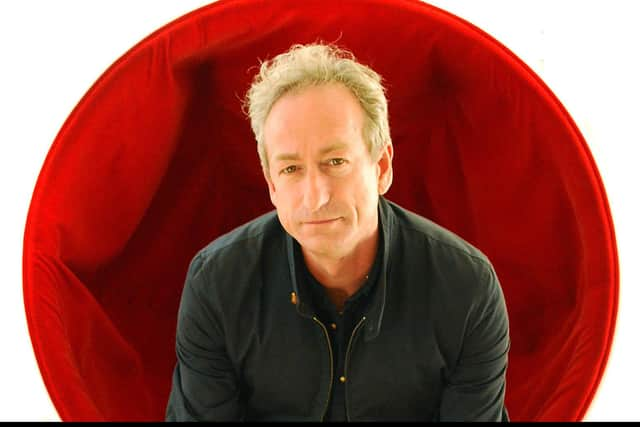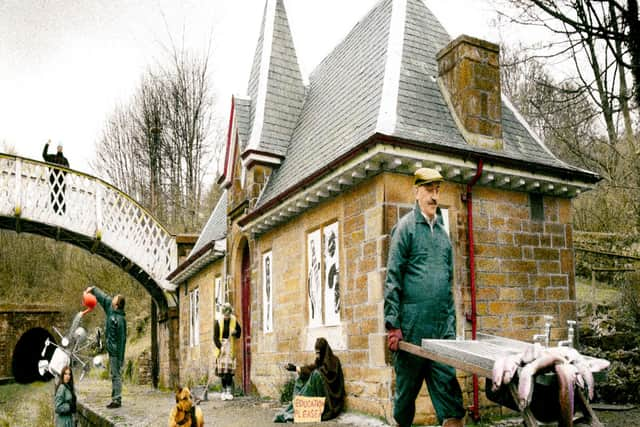What's The Story (Morning Glory) is 25 – here's how a Sheffield photographer created the covers for Oasis’ classic records
and live on Freeview channel 276
"If that was the brief – the band shot with the lead singer on the floor, a globe hanging from the ceiling – the opportunities for that to go wrong are enormous," says Michael Spencer Jones, the Sheffield-born photographer who was tasked with capturing the ideal image for the LP.
As it happened, the picture's on-the-hoof composition – frontman Liam Gallagher lying on the floorboards with brother Noel strumming a guitar on the sofa, as the rest of the group watch TV in the front room of rhythm guitarist Paul 'Bonehead' Arthurs' home – worked a treat, creating one of the all-time classic record sleeves.
Advertisement
Hide AdAdvertisement
Hide Ad"I love it," says Michael, who has put together an exhibition ahead of the album's 25th anniversary in August. "It's surreal and elevates them as a band but without glamourising them – normal, but not. All the elements come together."
Michael, who went on to make the cover pictures for all of Oasis' albums and singles until 1997, was one of the first people to hear the era-defining Manchester band's first album, and afterwards felt the pressure to deliver.
"You can just imagine putting that on and listening to tunes like Live Forever and Rock'n'Roll Star,” he says. “It was like 'Wow, that's really good'. There was never any doubt that album was going to be anything other than very significant.”
Creating a photo specifically for a record cover is not an easy assignment, he explains, ‘especially if you’re given carte blanche’. “If you have a bad day at the office, you can go home and forget about it, but if you have a bad day at the office and you happen to take pictures, everyone's going to see that, every time they pick that record up."
Advertisement
Hide AdAdvertisement
Hide AdAn album sleeve, he says, isn't a piece of ephemeral packaging - instead he believes it is integral to the listening experience.


"It's the only reference you have to connect with the music. If I say 'Abbey Road', you immediately think of The Beatles on that zebra crossing. The two are inextricably linked. I believe it becomes part of the creative content. Beethoven and Mozart did some great music but there are no pictorial references to any of that stuff. All classical record covers are pictures of stately homes, or a violin or something. It's all a very generic style, which is a shame."
Michael grew up in Hunters Bar – "That was my manor" – and went to King Edward VII school, before taking a succession of factory jobs at the likes of Bassett’s confectionery and Batchelors foods.
"I just chose all the wrong subjects and I failed all my A-levels. I got unclassified in all of them, it was a real disaster."
Advertisement
Hide AdAdvertisement
Hide AdHe returned to education aged 21, studying A-level art and photography and a City and Guilds qualification at Richmond College. The seeds of a career in photography had been planted much earlier, however.


"My dad had this anniversary copy of Life magazine – I can remember it lying around as a kid. It was amazing. That was the first moment when I thought 'wow'. It just had everything – photos taken through the human eye, infrared photography, then reportage stuff from America, the deep south and all the civil rights stuff. When I took it as a whole, I was sold on various aspects of it."
Photography, he says, was the 'perfect medium' for him.
"Artistically, I was really into it, but the science side of it fascinated me. Originally you used to get a photographic print, do it in the darkroom under the enlarger and then put it in chemicals, and then the image would just come up from nowhere like this thing that materialises in front of your very eyes. For anyone who's never gone through that – or anyone who has – that's a moment you never forget. It's such a beautiful thing."
Did taking good pictures come easily?


"I always feel a little bit detached. I think that's a photographer's trait, really. Then you start searching out images. I think someone once said 'Photography is the capacity to see what other people can’t’. I was very into that searching element."
The job has certain benefits, too.
Advertisement
Hide AdAdvertisement
Hide Ad"It can get you into situations, or privileged places, you wouldn't ordinarily be allowed to get to. That appealed to me."
Armed with his first proper camera - a Praktica Super TL made in East Germany, bought from Harrisons on London Road - he started dabbling in music photography in Sheffield, before heading to the south coast to study at Bournemouth & Poole Art College.
A move to Manchester followed. He arrived in 1989, when the 'Madchester' scene was in full swing and bands such as Stone Roses and Happy Mondays were making the charts.
"It was all happening, a really exciting place," he says. "It just felt like there was something in the air."


Advertisement
Hide AdAdvertisement
Hide AdMichael began working with local groups - the image he shot for The Verve's All In The Mind, the Wigan band's first single, was the one that got him noticed with Noel Gallagher.
"I think Noel said early on 'We're going to release a single every 10 weeks', or something, and I thought 'That's great news'," he says.
"All the bands, with very few exceptions, have all been great to work with. Of all people to hang out with, musicians are probably the most interesting and fun."
His cover photo for Definitely Maybe was followed by sleeves for the LPs (What's The Story) Morning Glory? and Be Here Now. The latter involved submerging a Rolls-Royce in a swimming pool, inspired by a mythical incident linked to hellraiser Keith Moon, the late drummer with The Who. Pictures of the car were ubiquitous, plastered seemingly everywhere on street posters in the run-up to the much-hyped album's release in 1997.
Advertisement
Hide AdAdvertisement
Hide AdHis image for The Verve's Urban Hymns the same year was more low-key, depicting the musicians turning their heads to look at deer in Windsor Park.
"Photography is no different from being a chef, you've got to get all the ingredients right," Michael says. "If something's slightly out of place the whole balance of the shot is lost."
Oasis split up 10 years ago this summer. Michael is doubtful that Liam and Noel will reunite any time soon.
"As of March 2019, the chances of them reforming are very slim. If they were to reform, it's more for nostalgic reasons. But it'd be good – and it'd be good if they got back in the studio and made some music, because I think they could still put out a couple more great albums."
Advertisement
Hide AdAdvertisement
Hide AdWould he be back behind the camera for a potential comeback LP?
"Yes, absolutely, if I was asked to do it."
Michael's exhibition, Setting The Scene: Oasis 25, is at the Browse Gallery in Berlin until April 7, 2019. Stints in London, Cheltenham and Liverpool are lined up later this year.
"I'll be bringing it to Sheffield if I can find a suitable venue," he says. "It explores how they were created, and the stories behind them, and I've got a few props and stuff from the covers. It takes you through the creative process. I was receiving all these emails from various fans around the world asking 'Where did you take that?' and then you get people revisiting the locations and recreating the covers. It became apparent to me that, apart from the music, the covers were connecting with people."
Sensibly, he’s retained the copyright on all of his images. “It was my business ethos - as an artist, you have to own what you create. The 1988 Copyright Act was the first time, in law, photographers had been recognised as artists.”
Advertisement
Hide AdAdvertisement
Hide AdHe sends out limited edition prints to enthusiasts across the world – his most recent consignments were dispatched to the USA and France.
Michael, 59, now lives in Knutsford, not too far from where his 19-year-old son is studying film production at Salford University.
"I really didn't want him to do photography," he admits. "It's different now. Film is where it's at. Everyone's got a camera."
Visit www.spellboundgalleries.com for further details.
‘If you can't find it in your own backyard, you're never going to’
Advertisement
Hide AdAdvertisement
Hide AdMichael Spencer Jones didn’t have to venture too far to find locations for some of his best-known work.
The sleeve for Oasis’ 1994 single Whatever was photographed at Ringinglow in Sheffield – the simple picture of a lush field was meant to evoke a sense of freedom, chiming with the song’s theme. It replaced the original idea of an open space in Arizona, as the always-combustible Gallagher brothers fell out on a US tour, putting the band’s future briefly in doubt.
“That was quite ironic, the notion that I flew halfway round the world to do a cover and then ended up photographing it literally five minutes from where I grew up,” says Michael. “It's that sentiment – if you can't find it in your own backyard, you're never going to.”
The cover picture for The Verve’s best of compilation This Is Music was taken just off the A57 Snake Pass, while the surreal image for Oasis’ 1995 single Some Might Say – their first number one – was created at Cromford Station near Matlock.
This interview was originally published in The Star, Sheffield, in March 2019.